The smart touch screen scale market is valued at USD 132.3 million in 2025 and is expected to reach USD 209.4 million by 2035, supported by rising digital transformation across retail checkout systems, automated weighing processes in fresh food sections, and standardized measurement requirements across logistics and industrial workflows. Smart touch screen scales provide integrated weighing, pricing, inventory linkage, and customer display functionality within a single device, making them well suited for supermarkets, specialty food outlets, warehouse packaging environments, and parcel dispatch operations. Growing emphasis on transaction accuracy, quick customer throughput, and traceable measurement records continues to drive adoption across multiple commercial environments.
From 2025 to 2030, the market increases from USD 132.3 million to approximately USD 166.5 million, adding USD 34.2 million and accounting for 44 percent of total decade expansion. This phase is driven by retail modernization, digitization of produce counters, and the expansion of self-checkout zones where clear display readability and automated pricing linkage are essential. From 2030 to 2035, the market grows from USD 166.5 million to USD 209.4 million, adding USD 42.9 million or 56 percent of decade growth. This later stage reflects broader integration with cloud-based POS systems, centralized inventory analytics platforms, and network-connected labeling workflows. Manufacturers providing reliable touch interface durability, multi-language support, and compatibility with retail software ecosystems maintain strong competitive positioning as smart scales shift from optional upgrades to core operational assets in the retail and logistics environment.
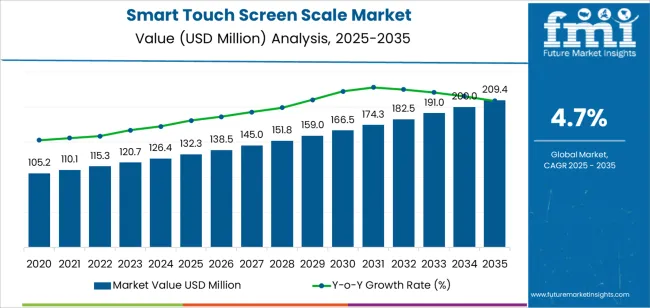
The latter half (2030-2035) will witness continued growth from USD 166.5 million to USD 209.4 million, representing an addition of USD 42.9 million or 56% of the decade's expansion. This period will be defined by mass market penetration of high-capacity weighing technologies, integration with comprehensive point-of-sale platforms, and seamless compatibility with existing retail infrastructure. The market trajectory signals fundamental shifts in how retail and industrial facilities approach weighing operations and transaction management, with participants positioned to benefit from growing demand across multiple capacity segments and application categories.
| Period | Primary Revenue Buckets | Share | Notes |
|---|---|---|---|
| Today | New scale sales (retail, industrial, logistics) | 56% | Modernization-driven, accuracy-focused purchases |
| Replacement & upgrade units | 22% | Technology refresh, capacity expansion | |
| Service & calibration contracts | 14% | Maintenance support, accuracy certification | |
| Software & connectivity solutions | 8% | POS integration, data management | |
| Future (3-5 yrs) | Integrated POS systems | 48-52% | Cloud connectivity, payment integration |
| Subscription software services | 16-20% | Inventory management, analytics platforms | |
| Hardware sales | 18-22% | Advanced displays, IoT-enabled scales | |
| Calibration & maintenance | 10-13% | Accuracy verification, compliance services | |
| Data analytics services | 6-9% | Sales insights, inventory optimization | |
| Custom integration | 4-6% | ERP connectivity, specialized applications |
At-a-Glance Metrics
| Metric | Value |
|---|---|
| Market Value (2025) | USD 132.3 million |
| Market Forecast (2035) | USD 209.4 million |
| Growth Rate | 4.7% CAGR |
| Leading Technology | Maximum Weighing Capacity <15kg |
| Primary Application | Retail Segment |
The market demonstrates strong fundamentals with lightweight capacity scale systems capturing a dominant share through advanced measurement capabilities and retail transaction optimization. Retail applications drive primary demand, supported by increasing store modernization and customer service requirements. Geographic expansion remains concentrated in developed markets with established retail infrastructure, while emerging economies show accelerating adoption rates driven by retail expansion initiatives and rising technology standards.
Primary Classification: The market segments by weighing capacity into maximum weighing capacity <15kg and maximum weighing capacity ≥15kg, representing the evolution from basic retail scales to sophisticated weighing solutions for comprehensive commercial measurement optimization.
Secondary Classification: Application segmentation divides the market into retail, industrial manufacturing, logistics, and others, reflecting distinct requirements for measurement accuracy, operational efficiency, and transaction processing standards.
Regional Classification: Geographic distribution covers North America, Latin America, Western Europe, Eastern Europe, East Asia, South Asia Pacific, and Middle East & Africa, with developed markets leading adoption while emerging economies show accelerating growth patterns driven by retail modernization expansion programs.
The segmentation structure reveals technology progression from standard weighing equipment toward sophisticated touch screen systems with enhanced connectivity and transaction capabilities, while application diversity spans from retail stores to industrial facilities requiring precise weight measurement solutions.

Market Position: Maximum Weighing Capacity <15kg systems command the leading position in the smart touch screen scale market with 58% market share through advanced retail features, including superior precision accuracy, operational convenience, and transaction processing optimization that enable retail facilities to achieve optimal weighing consistency across diverse grocery and specialty store environments.
Value Drivers: The segment benefits from retail facility preference for compact weighing systems that provide consistent measurement performance, reduced counter space requirements, and operational efficiency optimization without requiring significant infrastructure modifications. Advanced design features enable automated pricing calculation, barcode integration, and compatibility with existing point-of-sale equipment, where operational performance and customer service represent critical facility requirements.
Competitive Advantages: Maximum Weighing Capacity <15kg systems differentiate through proven operational reliability, consistent measurement characteristics, and integration with retail transaction systems that enhance facility effectiveness while maintaining optimal accuracy standards suitable for diverse grocery and specialty retail applications.
Key market characteristics:
Maximum Weighing Capacity ≥15kg systems maintain a 42% market position in the smart touch screen scale market due to their heavy-duty measurement properties and industrial application advantages. These systems appeal to facilities requiring high-capacity weighing with competitive pricing for manufacturing and logistics applications. Market growth is driven by industrial expansion, emphasizing reliable weighing solutions and operational efficiency through optimized system designs.
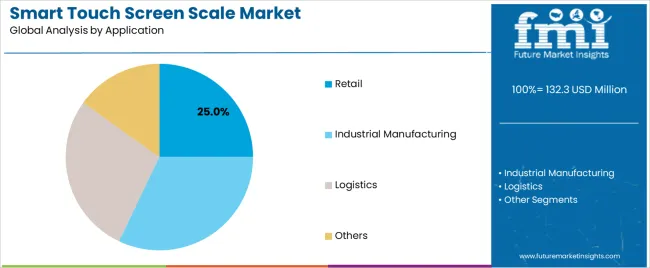
Market Context: Retail applications accounts for 25% market share and demonstrate the highest growth rate in the smart touch screen scale market with 5.6% CAGR due to widespread adoption of modernized weighing systems and increasing focus on customer service optimization, transaction efficiency enhancement, and store management applications that maximize operational effectiveness while maintaining accuracy standards.
Appeal Factors: Retail facility operators prioritize system versatility, transaction speed, and integration with existing point-of-sale infrastructure that enables coordinated weighing operations across multiple store departments. The segment benefits from substantial retail investment and modernization programs that emphasize the acquisition of touch screen scale systems for customer service optimization and transaction efficiency applications.
Growth Drivers: Store modernization programs incorporate smart weighing systems as standard equipment for retail operations, while e-commerce integration growth increases demand for flexible measurement capabilities that comply with accuracy standards and minimize transaction complexity.
Market Challenges: Varying product types and pricing requirements may limit system standardization across different retail formats or merchandise scenarios.
Application dynamics include:
Industrial Manufacturing applications capture significant market share through quality control requirements in production facilities, packaging operations, and manufacturing processes. These applications demand robust weighing systems capable of operating in industrial environments while providing effective measurement accuracy and operational reliability capabilities.
Logistics applications account for substantial market share, including shipping operations, warehouse management, and freight handling requiring accurate weighing capabilities for operational optimization and cost calculation.
| Category | Factor | Impact | Why It Matters |
|---|---|---|---|
| Driver | Retail modernization & digital transformation (omnichannel retail, self-service) | ★★★★★ | Stores upgrade weighing systems for improved customer experience; modern scales with touch screens and connectivity enable faster transactions and inventory management. |
| Driver | Legal-for-trade compliance & accuracy requirements | ★★★★★ | Regulatory standards mandate certified scales; vendors offering compliant solutions with calibration support gain competitive advantage in retail and commercial markets. |
| Driver | E-commerce growth & fulfillment center expansion | ★★★★☆ | Online grocery and delivery services need accurate weighing; logistics facilities require integrated scales for order processing and shipping operations. |
| Restraint | High cost compared to traditional scales | ★★★★☆ | Small retailers defer smart scale purchases; price differential slows adoption in price-sensitive segments and emerging markets. |
| Restraint | Technical complexity & training requirements | ★★★☆☆ | Staff adaptation challenges and software learning curves limit deployment speed and operational integration in smaller facilities. |
| Trend | Cloud connectivity & data analytics integration | ★★★★★ | Connected scales enable inventory tracking, sales analytics, and predictive ordering; cloud platforms transform scales into business intelligence tools. |
| Trend | Self-service & customer-facing applications | ★★★★☆ | Consumer preference for self-checkout drives demand; touch screen scales enable customer-operated weighing and pricing in retail environments. |
The smart touch screen scale market demonstrates varied regional dynamics with Growth Leaders including China (6.3% growth rate) and India (5.9% growth rate) driving expansion through retail modernization initiatives and commercial development. Steady Performers encompass Germany (5.4% growth rate), Brazil (4.9% growth rate), and developed regions, benefiting from established retail sectors and advanced technology adoption. Emerging Markets feature United States (4.5% growth rate) and United Kingdom (4.0% growth rate), where retail technology and store modernization initiatives support consistent growth patterns.
Regional synthesis reveals East Asian markets leading adoption through retail expansion and technology development, while North American countries maintain steady expansion supported by retail innovation advancement and compliance standardization requirements. European markets show moderate growth driven by retail applications and digital integration trends.
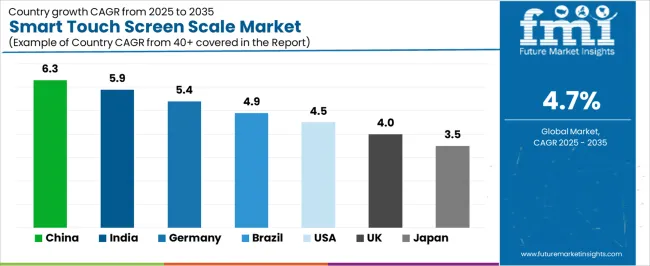
| Region/Country | 2025-2035 Growth | How to win | What to watch out |
|---|---|---|---|
| China | 6.3% | Lead with integrated solutions | Intense price competition; local brands |
| India | 5.9% | Focus on organized retail growth | Infrastructure challenges; fragmented market |
| Germany | 5.4% | Provide precision engineering | Regulatory complexity; price expectations |
| Brazil | 4.9% | Value-oriented models | Economic volatility; import costs |
| United States | 4.5% | Emphasize POS integration | Market maturity; established competition |
| United Kingdom | 4.0% | Push omnichannel solutions | Brexit impacts; retail consolidation |
| Japan | 3.5% | Advanced quality systems | Conservative adoption; established base |

China establishes fastest market growth through aggressive retail modernization programs and comprehensive commercial development, integrating advanced smart touch screen scales as standard components in supermarket chains, specialty stores, and logistics installations. The country's 6.3% growth rate reflects rising consumer spending and retail infrastructure capabilities that mandate the use of modern weighing systems in commercial and retail facilities. Growth concentrates in major urban centers, including Beijing, Shanghai, and Guangzhou, where retail technology development showcases integrated weighing systems that appeal to store operators seeking advanced transaction optimization capabilities and customer service applications.
Chinese manufacturers are developing cost-effective touch screen scale solutions that combine domestic production advantages with advanced operational features, including automated pricing systems and enhanced connectivity. Distribution channels through retail equipment suppliers and commercial service distributors expand market access, while rising retail standards support adoption across diverse commercial and specialty retail segments.
Strategic Market Indicators:
In Delhi, Mumbai, and Bengaluru, retail facilities and commercial establishments are implementing advanced smart touch screen scales as standard equipment for transaction processing and customer service applications, driven by increasing organized retail expansion and store modernization programs that emphasize the importance of technology capabilities. The market holds a 5.9% growth rate, supported by retail infrastructure development programs that promote modern weighing systems for commercial and retail facilities. Indian operators are adopting touch screen scales that provide consistent operational performance and transaction efficiency features, particularly appealing in urban regions where customer service and operational speed represent critical competitive requirements.
Market expansion benefits from growing organized retail capabilities and technology partnerships that enable wider distribution of modern weighing systems for retail and commercial applications. Product adoption follows patterns established in retail technology, where reliability and ease-of-use drive purchasing decisions and operational deployment.
Market Intelligence Brief:
Germany establishes market leadership through comprehensive retail standards and advanced measurement technology development, integrating smart touch screen scales across supermarkets, specialty retailers, and industrial applications. The country's 5.4% growth rate reflects established retail relationships and mature weighing technology adoption that supports widespread use of certified measurement systems in commercial and retail facilities. Growth concentrates in major retail centers, where measurement technology showcases mature scale deployment that appeals to retailers seeking proven accuracy capabilities and compliance applications.
German equipment providers leverage established distribution networks and comprehensive service capabilities, including calibration programs and technical support that create customer relationships and operational advantages. The market benefits from mature legal-for-trade standards and commercial requirements that mandate certified weighing system use while supporting technology advancement and operational optimization.
Market Intelligence Brief:
Brazil's market expansion benefits from diverse retail demand, including store modernization in São Paulo and Rio de Janeiro, commercial facility upgrades, and organized retail programs that increasingly incorporate smart weighing solutions for customer service applications. The country maintains a 4.9% growth rate, driven by rising retail activity and increasing recognition of modern weighing technology benefits, including improved transaction speed and enhanced customer experience.
Market dynamics focus on value-oriented touch screen scale solutions that balance advanced operational performance with affordability considerations important to Brazilian retailers. Growing retail modernization creates continued demand for modern weighing systems in new store infrastructure and commercial upgrade projects.
Strategic Market Considerations:
United States establishes steady growth through comprehensive retail programs and advanced commercial infrastructure development, integrating smart touch screen scales across grocery stores, specialty retailers, and logistics applications. The country's 4.5% growth rate reflects established retail relationships and mature weighing technology adoption that supports widespread use of certified measurement systems in commercial and retail facilities. Growth concentrates in major retail markets, where store technology showcases established scale deployment that appeals to operators seeking proven measurement capabilities and POS integration applications.
American equipment providers leverage established distribution networks and comprehensive service capabilities, including installation support and calibration services that create customer relationships and operational advantages. The market benefits from mature legal-for-trade standards and commercial requirements that mandate certified weighing system use while supporting technology advancement and operational optimization.
Market Intelligence Brief:
United Kingdom's retail technology market demonstrates sophisticated smart touch screen scale deployment with documented operational effectiveness in grocery applications and commercial facilities through integration with existing point-of-sale systems and retail infrastructure. The country leverages retail innovation and technology adoption to maintain a 4.0% growth rate. Retail centers, including London, Manchester, and Birmingham, showcase advanced installations where touch screen scales integrate with comprehensive retail platforms and store management systems to optimize transaction operations and customer service effectiveness.
British retailers prioritize system reliability and POS compatibility in weighing equipment selection, creating demand for advanced systems with enhanced features, including cloud connectivity and automated inventory integration. The market benefits from established retail technology infrastructure and a willingness to invest in modern store equipment that provides operational benefits and enhances customer experience.
Market Intelligence Brief:
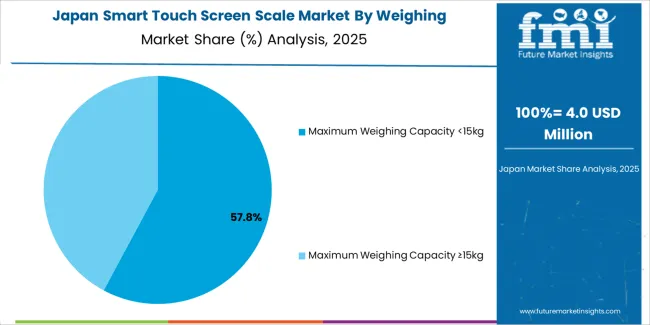
Japan's market growth is driven by precision measurement tradition and retail excellence, with smart touch screen scales deployed across supermarkets, department stores, and specialty retailers. The country maintains a 3.5% growth rate through established retail infrastructure and technology leadership in measurement systems. Japanese retailers emphasize accuracy and reliability, creating demand for premium weighing solutions with advanced features and rigorous certification standards.
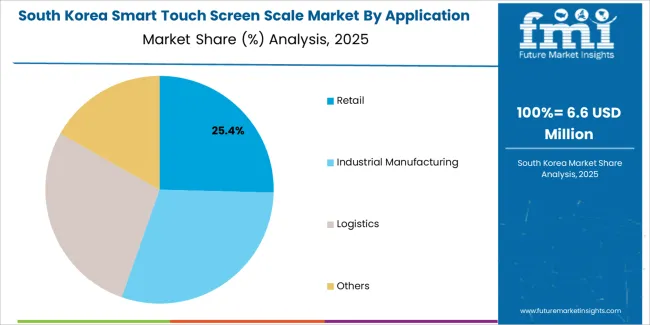
South Korea's smart touch screen scale market expansion benefits from comprehensive retail modernization and technology adoption in supermarket chains, convenience stores, and logistics facilities. The country's growth trajectory reflects consumer technology acceptance and retail innovation initiatives that promote advanced weighing adoption for customer service enhancement and operational efficiency optimization.
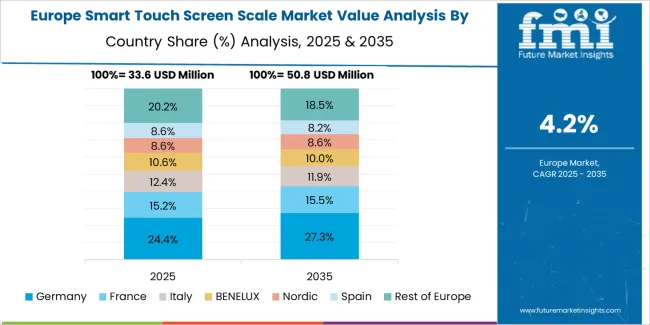
The smart touch screen scale market in Europe is projected to grow from USD 48.6 million in 2025 to USD 73.8 million by 2035, registering a CAGR of 4.3% over the forecast period. Germany is expected to maintain its leadership position with a 36.8% market share in 2025, supported by its advanced retail infrastructure and stringent legal-for-trade standards across major commercial centers.
France follows with a 21.4% share in 2025, driven by comprehensive retail modernization programs in supermarket chains and specialty stores. The United Kingdom holds a 17.2% share through established retail technology adoption and omnichannel integration requirements. Italy commands a 13.1% share, while Spain accounts for 8.6% in 2025. The rest of Europe region is anticipated to gain momentum, expanding its collective share from 2.9% to 4.2% by 2035, attributed to increasing smart scale adoption in Nordic countries and emerging Eastern European retail chains implementing store modernization programs.

The competitive structure encompasses 12-18 credible players, with the top 5 holding approximately 54-60% by revenue. Leadership is maintained through certification networks, technical support, and technology innovation combining measurement accuracy, user interface design, and connectivity integration capabilities. Basic weighing mechanisms and standard display interfaces are commoditizing, while margin opportunities exist in software solutions, POS integration, and incorporation into retail workflows including inventory management systems and analytics platforms.
Global platforms control distribution reach and comprehensive product portfolios with service networks, providing broad availability and proven compliance across multi-region markets. Their typical blind spots include local retail preferences and price-sensitive segment penetration that may limit market share in emerging regions. Technology innovators maintain R&D capabilities with advanced touch interfaces and cloud connectivity, offering latest features first with attractive ROI on operational efficiency, though they face regional service challenges and price competition from local manufacturers.
Regional specialists control local compliance expertise, fast delivery, and application knowledge, providing proximity support with competitive pricing and regulatory familiarity. However, they encounter technology limitations and international expansion constraints in service operations. Certified solution providers maintain legal-for-trade certification, calibration services, and compliance documentation, achieving differentiation through regulatory expertise and measurement assurance, though certification costs and regional regulation complexity represent operational challenges.
Software-focused players emphasize POS integration, cloud analytics, and inventory management capabilities, winning modern retail customers with comprehensive digital solutions and data insights. Their hardware dependency and integration complexity represent business model challenges. The competitive environment emphasizes certification compliance, software capabilities, and retail integration as key differentiators, with successful players combining measurement precision with comprehensive digital solutions and industry expertise that addresses diverse operational requirements across retail, industrial, and logistics sectors.
| Item | Value |
|---|---|
| Quantitative Units | USD million |
| Weighing Capacity | Maximum Weighing Capacity <15kg, Maximum Weighing Capacity ≥15kg |
| Application | Retail, Industrial Manufacturing, Logistics, Others |
| Regions Covered | North America, Latin America, Western Europe, Eastern Europe, East Asia, South Asia Pacific, Middle East & Africa |
| Countries Covered | United States, China, Germany, India, United Kingdom, Japan, Brazil, France, South Korea, Australia, and 25+ additional countries |
| Key Companies Profiled | Marel, Mettler-Toledo, Wedderburn, Grupo Epelsa, DEM, Xiamen Rongta Technology Group, Shenzhen General Measure Technology, Xiamen HPRT |
| Additional Attributes | Dollar sales by weighing capacity and application categories, regional adoption trends across East Asia, North America, and Western Europe, competitive landscape with weighing equipment manufacturers and retail technology suppliers, retail operator preferences for measurement accuracy and system integration, compatibility with POS platforms and inventory management systems, innovations in touch screen technology and connectivity enhancement, and development of smart weighing solutions with enhanced performance and retail optimization capabilities. |
The global smart touch screen scale market is estimated to be valued at USD 132.3 million in 2025.
The market size for the smart touch screen scale market is projected to reach USD 209.4 million by 2035.
The smart touch screen scale market is expected to grow at a 4.7% CAGR between 2025 and 2035.
The key product types in smart touch screen scale market are maximum weighing capacity <15kg and maximum weighing capacity ≥15kg.
In terms of application, retail segment to command 25.0% share in the smart touch screen scale market in 2025.






Full Research Suite comprises of:
Market outlook & trends analysis
Interviews & case studies
Strategic recommendations
Vendor profiles & capabilities analysis
5-year forecasts
8 regions and 60+ country-level data splits
Market segment data splits
12 months of continuous data updates
DELIVERED AS:
PDF EXCEL ONLINE
Smart Vision Processing Chips Market Size and Share Forecast Outlook 2025 to 2035
Smart Magnetic Drive Conveyor System Market Size and Share Forecast Outlook 2025 to 2035
Smart Wheelchair market Size and Share Forecast Outlook 2025 to 2035
Smart Mining Technologies Market Size and Share Forecast Outlook 2025 to 2035
Smart Parking Market Size and Share Forecast Outlook 2025 to 2035
Smart Digital Valve Positioner Market Forecast and Outlook 2025 to 2035
Smart Card IC Market Size and Share Forecast Outlook 2025 to 2035
Smart-Tag Inlay Inserters Market Analysis - Size and Share Forecast Outlook 2025 to 2035
Smart TV Market Forecast and Outlook 2025 to 2035
Smart/AI Toy Market Size and Share Forecast Outlook 2025 to 2035
Smart Locks Market Size and Share Forecast Outlook 2025 to 2035
Smart Sprinkler Controller Market Size and Share Forecast Outlook 2025 to 2035
Smart Indoor Gardening System Market Size and Share Forecast Outlook 2025 to 2035
Smart Building Delivery Robot Market Size and Share Forecast Outlook 2025 to 2035
Smart Watch Market Size and Share Forecast Outlook 2025 to 2035
Smart Label Market Size and Share Forecast Outlook 2025 to 2035
Smart Mat Market Size and Share Forecast Outlook 2025 to 2035
Smart Water Management Market Size and Share Forecast Outlook 2025 to 2035
Smart Built-In Kitchen Appliance Market Size and Share Forecast Outlook 2025 to 2035
Smart Cold Therapy Machine Market Size and Share Forecast Outlook 2025 to 2035

Thank you!
You will receive an email from our Business Development Manager. Please be sure to check your SPAM/JUNK folder too.
Chat With
MaRIA